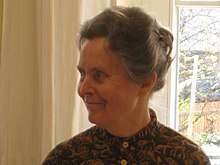Gudrun Kalmbach
Gudrun Kalmbach (born 27 May 1937 in Großerlach) is a German mathematician and educator known for her contributions in the field of quantum logic and for the educational programmes she developed.
Gudrun Kalmbach | |
|---|---|
 | |
| Born | 27 May 1937 Großerlach |
| Nationality | German |
| Alma mater | Georg-August-Universität Göttingen |
| Scientific career | |
| Fields | Quantum Logic, Measure Theory, |
| Institutions | Universität Ulm |
| Thesis | Über nieder dimensionale CW-komplexe in nichtkompakten Mannigfaltigkeiten (1966) |
| Doctoral advisor | Hans Grauert |
Career
After teacher training in mathematics and chemistry, Kalmbach obtained a PhD at the University of Göttingen under the supervision of Hans Grauert on the topic of low-dimensional CW complexes in non-compact manifolds.
From 1967 to 1969, Kalmbach taught at the University of Illinois at Urbana–Champaign. After this she held positions as assistant professor at the University of Massachusetts Amherst (1970–1971) and Pennsylvania State University (1969–1975). In 1975, she qualified as professor at the University of Ulm, becoming the first female professor in geometry (at the chair of number theory and probability theory).[1] She worked there until her retirement in 2002.
Kalmbach's research deals with manifolds, lattice theory and quantum structures.[2] She was involved in developing the field of quantum structures in the 1990s. Her current research project is MINT-Wigris.
In addition to her research career, Kalmbach invented in 1985 the talent program in STEM subjects (called MINT in Germany).[3],[4] Part of this is the yearly mathematics competition at the University of Ulm.[5] From this, pupils were selected to attend a mathematics summer school with teaching in computer science, chemistry, physics and where they were introduced to university mathematics.[6]
She was a founder of European Women in Mathematics,[7] and a member and chair of the Emmy Noether Verein which supports female mathematicians.[8]
Kalmbach now lives in Bad Wörishofen.[9]
Selected publications
- Kalmbach, Gudrun (1983). Orthomodular lattices. London New York: Academic Press. ISBN 0123945801.[10]
- Kalmbach, Gudrun (1986). Measures and Hilbert lattices. Singapore: World Scientific. ISBN 9971500094.[11]
- Kalmbach, Gudrun (1988). Diskrete Mathematik : ein Intensivkurs für Studienanfänger mit Turbo Pascal-Programmen. Braunschweig: Vieweg. ISBN 3528063033.[12]
- Kalmbach, Gudrun (1996). Mathematik - bunt gemischt. Velten: Becker. ISBN 389597269X.
- Kalmbach, Gudrun (1998). Quantum measures and spaces. Dordrecht Boston: Kluwer. ISBN 0792352882.[13]
- Kalmbach, Gudrun (2017). MINT-Wigris Volume 1-2. Bad Wörishofen: MINT Verlag. ISBN 978-3-9818217-1-0.
- Kalmbach (et al. ed.), Gudrun (2019). MINT (Mathematik, Informatik, Naturwissenschaften, Technik), Volume 1-40. Bad Wörishofen: MINT Verlag.
- Kalmbach H.E., G. ‘‘Archives KHE 1967-2019.‘‘ Bad Woerishofen, about 1000 volumes on science, mathematics, equal opportunity for women in mathematics
- Kalmbach, G. ‘‘Orthomodular Logic.‘‘ Z. Logik und Grundl. Math. 20 (1974), 395-406
- Kalmbach (ed.), G. ‘‘Proceedings of the Lattice Theory Conference.‘‘ Universitaet Ulm, 1975
- Kalmbach, G. ‘‘On some results in Morse Theory.‘‘ Canadian J. Math. 26 (1975), 88-105
- Kalmbach, G. ‘‘Extension of topological Homology Theory to Partially Ordered Sets.‘‘ J. reine und angew. Math. 280 (1976), 134-156
References
- Schröck, Martina. "Mehr Frauen in die Spitzenforschung". Augsburger Allgemeine (in German). Retrieved 2019-02-15.
- "Quantum structures II dedicated to Gudrun Kalmbach by the - Technische Informationsbibliothek (TIB)". www.tib.eu (in German). Retrieved 2019-03-05.
- "MINT-WIGRIS Startseite". mint-wigris.bplaced.net. Retrieved 2019-02-15.
- Kalmbach (et al. ed.), Gudrun (2019). MINT (Mathematik, Informatik, Naturwissenschaften, Technik), Volume 1-40. Bad Wörishofen: MINT Verlag.
- "Tag der Mathematik - Universität Ulm". www.uni-ulm.de. Retrieved 2019-02-15.
- "Kursinhalte 1985 bis 2001". mint-wigris.bplaced.net. Retrieved 2019-02-15.
- "European Women in Mathematics", MacTutor History of Mathematics archive, February 2018, retrieved 2019-09-28
- Internationale mathematische Nachrichten (in German). 1994. p. 6.
- Issing, Franz. ""Verstecktes Talent" geehrt". Augsburger Allgemeine (in German). Retrieved 2019-02-15.
- Stern, Manfred (1985). "Review of Orthomodular Lattices". Mathematical Reviews. MR 0716496.
- Gudder, S. (1988). "Review of Measures and Hilbert Lattices". Mathematical Reviews. MR 0867884.
- Vollrath, H.-J. (1989). "Review of Diskrete Mathematik". Mathematical Reviews. MR 0963058.
- Gudder, S. (1999). "Review of Quantum Measures and Spaces". Mathematical Reviews. MR 1662485.
- Houdek, Frank. "MINT-Wigris by Frank Houdek".
- Kalmbach, Gudrun. "MINT-Wigris project".